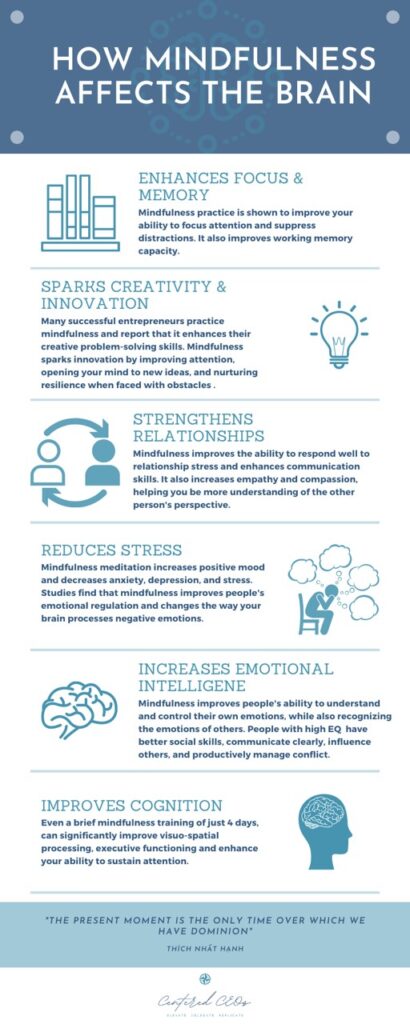Why Mindfulness is the CEO’s Superpower
In the whirlwind of corporate leadership, it’s easy to feel like you’re constantly sprinting on a treadmill with no stop button. Meetings, decisions, emails, and high-stakes negotiations dominate every hour. Amid this chaos, mindfulness might seem like a luxury—something reserved for monks or yoga retreats.
But increasingly, top executives are turning to mindfulness as a strategic advantage in high-pressure environments. According to Harvard Business Review, leaders who meditate regularly report enhanced clarity, emotional intelligence, and reduced burnout.
Even tech giants like Google and Intel have integrated mindfulness into their leadership training programs. Why? Because research shows that meditation improves cognitive function, decision-making speed, and stress resilience—critical qualities for those making billion-dollar decisions.
In fact, Marc Benioff, CEO of Salesforce, credits mindfulness for his business clarity and compassion-driven leadership.
This article isn’t about chanting mantras on a mountaintop. It’s about a pragmatic, science-backed, 5-minute practice that fits seamlessly into any busy executive’s day.
If you’ve ever said, “I don’t have time to meditate,” you’re exactly who this was designed for. Think of this as mental push-ups for CEOs—fast, focused, and transformative.
The High Cost of Mental Clutter
In today’s high-stakes leadership landscape, CEOs and executives are frequently victims of decision fatigue, a condition where the quality of decisions deteriorates after a long session of decision-making, as outlined by Fast Company. With so many daily micro-decisions, from approving budgets to navigating crises, mental bandwidth becomes a scarce resource.
Studies from Harvard Medical School confirm that mental clutter diminishes strategic thinking and creativity—two of the most valuable assets a leader possesses. When the brain is constantly overloaded, it becomes more reactive and less innovative, which leads to impulsive decisions and increased emotional reactivity, often derailing long-term goals.
Unchecked stress and chronic overthinking can have physiological consequences too. According to the American Psychological Association, executives report higher-than-average stress levels, contributing to anxiety, sleep disturbances, and even cardiovascular issues.
This isn’t just a personal health concern; it’s a business risk. Leaders who are mentally overwhelmed are more likely to experience burnout, which the World Health Organization has recognized as an occupational syndrome affecting productivity and workplace morale.
What Is the 5-Minute CEO Meditation?
The 5-Minute CEO Meditation is a condensed mindfulness practice that fits seamlessly into even the busiest executive’s schedule. It’s designed to deliver mental clarity, emotional grounding, and sharpened focus—without needing incense, silence, or a meditation cushion.
As explained by Mindful Leader, even short sessions of meditation can reset your attention and boost emotional control. Here’s how it works:
Minute 1: Breath Awareness – Begin by focusing on your breath. Inhale slowly through your nose, exhale gently through your mouth. This helps calm the nervous system, as shown by Harvard Health, and instantly reduces anxiety by activating the parasympathetic response.
Minute 2: Body Scan – Briefly scan your body from head to toe. Notice tension in your shoulders, neck, or jaw. According to the Cleveland Clinic, this helps you ground yourself physically and release accumulated stress.
Minute 3: Emotional Check-In – Acknowledge how you’re feeling without judgment. Are you anxious about an upcoming meeting? Frustrated by an unresolved conflict? Greater Good Science Center at UC Berkeley emphasizes that emotional awareness increases self-regulation and leadership effectiveness.
Minute 4: Intentional Focus – Choose a phrase, goal, or mantra for your day. It could be “Lead with clarity” or “Be present with my team.” This step, backed by research from Psychology Today, helps wire the brain toward purpose-driven actions.
Minute 5: Visualization – Mentally rehearse succeeding at your most important task. Athletes and CEOs alike use visualization to prime performance, and studies from Forbes show it boosts confidence and goal-oriented behavior.

This infographic highlights simple workplace meditation techniques to reduce stress and boost productivity, even in a busy office setting. It perfectly aligns with the idea of “The 5 Minute CEO Meditation,” offering quick, practical mindfulness tools tailored for time-strapped leaders.
Why It Works: The Science Behind Micro-Mindfulness
The power of the 5-minute meditation lies in neuroplasticity, the brain’s ability to rewire itself through consistent practice, as highlighted by Scientific American. Even a few minutes of mindful breathing each day can create new neural pathways associated with focus, emotional regulation, and resilience, which are critical for leadership performance.
Researchers from Harvard University found that short-term meditation can actually increase grey matter in areas of the brain linked to learning, memory, and emotion regulation. This means leaders who meditate, even briefly, build literal mental muscle to handle stress and complexity more effectively.
Moreover, mindfulness reduces activity in the brain’s default mode network (DMN), which is responsible for mind-wandering and self-referential thoughts. A study published in Nature Reviews Neuroscience confirms that this quieting of the DMN helps people stay grounded in the present moment, leading to better decision-making and reduced anxiety.
Business leaders are also drawn to mindfulness because of its proven impact on performance and productivity. According to McKinsey & Company, mindfulness enhances executive functioning skills like working memory, cognitive flexibility, and self-control—three pillars of successful leadership.
Overcoming Resistance: “I Don’t Have Time to Meditate”
Perhaps the most common objection to mindfulness among executives is the perceived lack of time. But the belief that meditation requires 30 uninterrupted minutes of silence is a myth. A report from Inc. Magazine demonstrates that even five-minute practices lead to noticeable improvements in focus and stress reduction.
Leading productivity expert David Allen emphasizes that “you can do anything, but not everything”—a reminder that reclaiming just five minutes can deliver a disproportionate return on your cognitive investment.
When leaders learn to prioritize mental clarity over mental busyness, they operate more strategically and less reactively.
Additionally, micro-practices have been shown to improve attention spans and lower cortisol levels, as evidenced by research published in the Journal of Cognitive Enhancement. Unlike traditional stress-relief methods that require hours or planning, these five minutes can be done between meetings, before a presentation, or even during your commute.
As Thich Nhat Hanh once said, “Smile, breathe and go slowly.” This reminder is especially powerful for CEOs, whose greatest strength often lies not in reacting quickly, but in responding wisely. The return on a five-minute investment in mindfulness isn’t just personal calm—it’s smarter leadership.
How Top CEOs Use Mindfulness to Win
Modern leaders are no longer hiding their meditation practices—they’re highlighting them as competitive assets. Marc Benioff, CEO of Salesforce, openly credits his mindfulness routine with helping him lead with both compassion and clarity, as featured in Business Insider. For Benioff, meditation isn’t a hobby—it’s a strategic leadership tool.
LinkedIn CEO Jeff Weiner also advocates daily meditation to enhance empathy and reduce reactive decision-making. He believes mindfulness helps him lead more consciously, as he explained in The Wall Street Journal.
This reflects a growing shift where emotional intelligence, once seen as a soft skill, is now recognized as a critical asset in high-stakes environments.
Even companies like Google, Intel, and Aetna have invested in mindfulness training at scale, seeing benefits in employee performance, stress reduction, and leadership effectiveness, according to Harvard Business Review. These organizations don’t view meditation as a wellness perk; they see it as a cultural cornerstone for sustainable leadership.
Aetna’s CEO, Mark Bertolini, introduced mindfulness programs to reduce healthcare costs and improve employee well-being after his own recovery journey. According to a report in The Atlantic, participants reported a 28% reduction in stress and a 20% improvement in sleep quality—indicating real-world returns on mindful investment.
Making It a Daily Habit: Integration Tips for Busy Leaders
The key to long-term success with the 5-minute CEO meditation is consistency, not perfection. According to James Clear, author of Atomic Habits, building a micro-habit like five minutes of meditation is more sustainable than trying to implement a drastic 30-minute routine all at once. Small changes compound into major results over time.
To make mindfulness stick, tie it to an existing habit—like doing it right after your morning coffee or before your first meeting. This concept, known as habit stacking, increases the likelihood of consistency and is supported by behavior design experts at Stanford University.
Using tech-enabled reminders, such as phone alarms or meditation apps like Headspace or Insight Timer, can provide structured support. These tools help executives stay accountable while delivering guided content tailored for busy professionals.
It also helps to create a mindful workspace. Even something as simple as a quiet corner with a chair and no digital distractions can make a big difference. Cal Newport argues that removing environmental triggers—like email notifications and clutter—can boost your ability to stay present and focused.
And remember, meditation doesn’t have to be perfect. Even on the days when your mind races, the practice still counts.
As mindfulness teacher Sharon Salzberg often says in her teachings, “The healing is in the return.” Every time you bring your attention back, you’re training your mind to lead better.

This infographic illustrates how mindfulness rewires the brain to enhance focus, creativity, and emotional intelligence—qualities essential for high-performing leaders. The 5-minute CEO meditation taps into these benefits, offering a quick yet powerful tool to boost leadership effectiveness.
Beyond the Boardroom: The Ripple Effects of Mindful Leadership
Mindfulness doesn’t just benefit the individual CEO—it transforms the entire workplace culture. When leaders model presence and clarity, it sets the tone for more grounded, purpose-driven teams.
A study published in the Academy of Management Journal found that mindful leadership enhances employee engagement, trust, and performance, especially in high-pressure environments.
Companies like SAP and General Mills have implemented formal mindfulness programs to foster emotional intelligence and improve collaboration. As detailed in Forbes, these initiatives resulted in improved employee well-being and higher innovation scores—demonstrating that mindful leadership is a business asset, not a luxury.
The ripple effects extend beyond business outcomes. When leaders approach their roles with intention, it encourages more ethical, inclusive, and human-centered decision-making.
Research from the Center for Compassion and Altruism Research and Education (CCARE) at Stanford suggests that compassionate leadership increases loyalty and productivity, creating an upward spiral of positivity across the organization.
This impact also influences external relationships. Mindful CEOs are more likely to nurture long-term partnerships and build authentic brands, as noted by Harvard Business Review. Stakeholders and consumers alike gravitate toward companies led by individuals who exude focus, empathy, and clarity of purpose.
Final Thoughts: The Future Belongs to the Present Leader
In an era defined by volatility and rapid change, the leaders who will thrive are not those who move the fastest, but those who can remain centered amidst chaos. The 5-minute meditation practice is a deceptively simple tool that offers exactly that: a space to reset, realign, and lead from a place of clarity.
The future of leadership is mindful. From the boardroom to global summits, decision-makers are increasingly turning inward to navigate outward challenges.
A 2022 report by the World Economic Forum emphasized the need for future leaders to develop inner resilience through mindfulness, self-awareness, and cognitive control.
Moreover, as mental health takes center stage in global conversations, CEOs who prioritize their own well-being send a powerful message to employees and society: productivity begins with presence. Organizations such as Mindful.org have been at the forefront of helping leaders embed these values into their daily routines.
As meditation teacher and author Jon Kabat-Zinn reminds us in his book, “You can’t stop the waves, but you can learn to surf.” In just five minutes a day, busy leaders can access the stillness that fuels vision, and the clarity that sustains it.
Resources to Kickstart Your Practice
Starting a meditation habit doesn’t require a silent retreat or a monk’s discipline—just the right tools and a bit of intention. Fortunately, there are a variety of free and premium resources available that make it easy for even the busiest executives to begin their mindfulness journey.
The Insight Timer app offers thousands of guided meditations, many as short as five minutes, and is widely regarded for its breadth and quality.
For those who prefer a more structured, science-based approach, Headspace provides curated programs specifically for stress, focus, leadership, and sleep. Its co-founder, former monk Andy Puddicombe, offers brief yet powerful sessions tailored to hectic schedules, making mindfulness approachable for professionals at any level.
Executives seeking deeper learning can also explore platforms like Mindful.org and Mindful Wholeness which offer guidance in the form of articles on integrating mindfulness into daily life and leadership.
For more research-driven content, the Greater Good Science Center at UC Berkeley shares the latest studies on mindfulness and its impact on the brain, productivity, and emotional intelligence.
For more advanced exploration, the free online offerings from UCLA’s Mindful Awareness Research Center (MARC) include weekly podcasts and recorded sessions by researchers and mindfulness teachers. These practices are grounded in decades of clinical research and help validate mindfulness as a critical leadership asset, not just a wellness trend.
Whether you’re starting from scratch or looking to refine your practice, the tools are abundant and accessible. The key is to start—one breath, one minute, one mindful moment at a time.
Frequently Asked Questions About The 5-Minute CEO Meditation
What is the 5-Minute CEO Meditation?
The 5-Minute CEO Meditation is a brief mindfulness practice designed specifically for busy leaders to quickly regain focus, reduce stress, and enhance decision-making without taking much time from their schedules.
How does the 5-minute meditation benefit busy leaders?
It helps leaders improve clarity, manage stress, boost emotional intelligence, and maintain calm under pressure, all within a manageable timeframe.
Do I need prior meditation experience to try this practice?
No, the meditation is simple and accessible for beginners as well as experienced practitioners.
Can the 5-minute meditation be done anywhere?
Yes, it can be performed in any quiet or semi-quiet space, whether in an office, at home, or even between meetings.
What is the best time of day to practice this meditation?
Many leaders find it effective to practice it in the morning to set a focused tone or midday to reset during stressful periods.
Will this meditation interfere with my work schedule?
Since it only takes five minutes, it easily fits into tight schedules without disrupting productivity.
What should I focus on during the meditation?
Focus on your breath, bodily sensations, or simply observing your thoughts without judgment to cultivate mindfulness.
How often should I practice the 5-minute meditation?
Daily practice is ideal, but even a few times a week can produce meaningful benefits.
Is this meditation scientifically proven to help with leadership challenges?
Yes, multiple studies show mindfulness improves focus, emotional regulation, and stress management—key leadership skills.
Can this meditation help reduce decision fatigue?
Absolutely, mindfulness helps clear mental clutter, enabling better and more confident decision-making.
Do I need any special equipment or apps?
No equipment is required, but some leaders find guided meditation apps helpful for consistency.
How do I stay motivated to meditate regularly?
Setting reminders, integrating meditation into your routine, and noticing early benefits can boost motivation.
Can meditation improve my interpersonal skills as a leader?
Yes, mindfulness enhances empathy, active listening, and emotional intelligence, improving team dynamics.
Is 5 minutes really enough to see benefits?
While longer sessions can be beneficial, even 5 minutes daily can improve focus and reduce stress over time.
How do I handle distractions during meditation?
Acknowledge distractions without judgment and gently return your focus to your breath or point of attention.
What if I don’t feel calm after meditation?
It’s normal for the mind to wander; with practice, calmness increases gradually.
Can this meditation improve creativity and problem-solving?
Yes, mindfulness fosters openness and mental flexibility, enhancing creativity.
How can I incorporate mindfulness into meetings or work calls?
Try mindful breathing before and during meetings to stay present and centered.
Is the 5-Minute CEO Meditation suitable for all leadership levels?
Yes, it benefits leaders at all levels seeking improved focus and stress management.
Where can I learn more about mindfulness for leaders?
Resources like Mindful.org, Mindful Wholeness, Harvard Business Review, and leadership mindfulness books provide excellent guidance.
-Authored By Pragna Chakraborty





